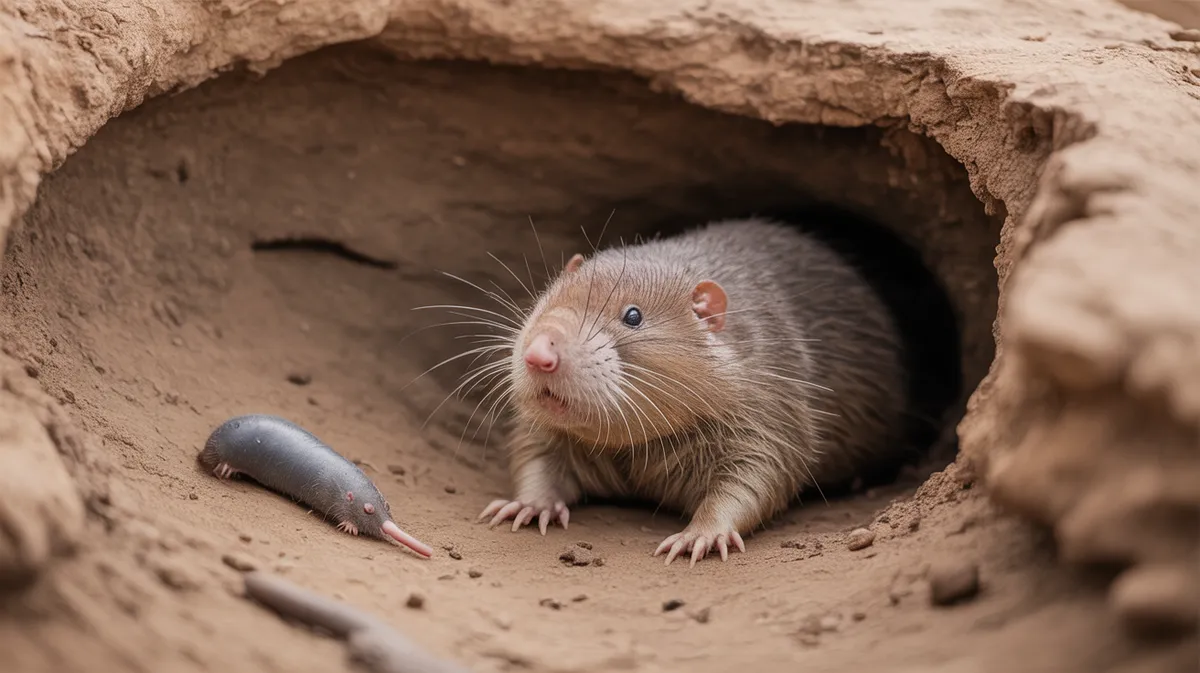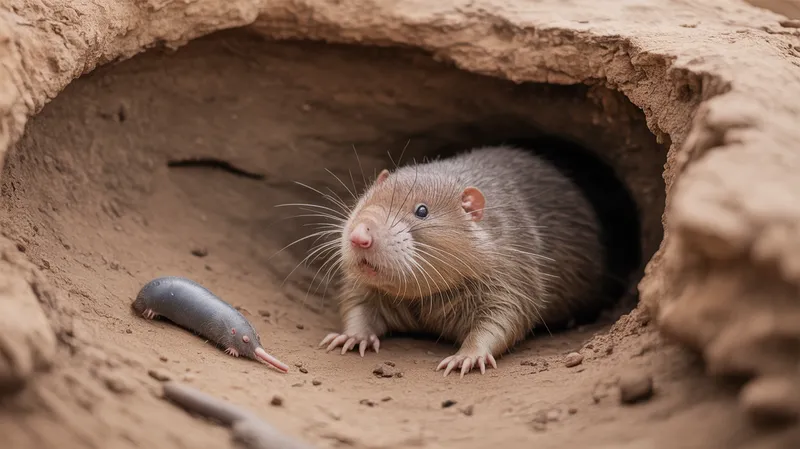
Damaraland Mole Rat
Fukomys damarensis

Meet the Damaraland Mole Rat
The Damaraland Mole Rat is a subterranean rodent native to the arid and semi-arid regions of southern Africa, particularly Namibia, Botswana, and Angola. It exhibits a highly social, eusocial lifestyle rarely seen in mammals, with colonies structured much like those of ants or termites and led by a single breeding female. Adapted to a life underground, this mole rat has small eyes, a cylindrical body, and large incisors used for digging through tough soil. Its fur is short and velvety, and it spends nearly its entire life in complex tunnel systems. The Damaraland Mole Rat plays a vital ecological role by aerating soil and facilitating nutrient recycling.
Classification
Mammal
Habitat
Subterranean burrows in semi-arid grasslands and savannas
Diet
Herbivore
Lifespan
7-15 years
Conservation
Least Concern
Weight
80-180 grams
📖Fascinating Facts
Eusocial Structure
Damaraland Mole Rats are one of only a handful of mammal species that are eusocial, with colonies led by a single queen and including non-reproductive workers.
Specialized Diet
Their diet consists mainly of underground tubers and roots, which they locate using their keen sense of smell and dig out with powerful incisors.
Low Oxygen Adaptation
They can survive in environments with very low oxygen and high carbon dioxide levels, making them well-suited for their subterranean lifestyle.
📋Detailed Description
The Damaraland mole-rat (Fukomys damarensis) is a medium-sized, robust subterranean rodent, measuring 14–18 cm in length and weighing between 90 and 180 grams, with females generally smaller than males. Its body is cylindrical and streamlined, covered in short, dense, velvety fur that ranges from brownish to gray, providing protection against abrasive soils. The eyes are small and functionally limited, reflecting its adaptation to a dark, underground environment, while the external ears are reduced to small openings. Powerful, ever-growing incisors protrude beyond the lips and are used for both digging and gnawing on tough underground plant material. The forelimbs are strong and equipped with large claws, further aiding in excavation. Damaraland mole-rats are highly eusocial, forming colonies that can contain up to 40 individuals, organized around a single breeding female (the 'queen'), several breeding males, and numerous non-breeding workers. Colonies construct extensive burrow systems, sometimes exceeding 1 km in total length, which provide protection from predators and harsh surface conditions. Communication within the colony relies on a range of vocalizations, tactile cues, and chemical signals. Their diet consists mainly of underground storage organs such as tubers and bulbs, which they locate using their keen sense of smell. The species is remarkably tolerant of hypoxic (low oxygen) and hypercapnic (high carbon dioxide) conditions, a physiological adaptation to life in poorly ventilated burrows. Damaraland mole-rats play a crucial ecological role in soil turnover and aeration, and their social structure and reproductive suppression mechanisms are of significant interest in evolutionary biology.
💡 Did you know?
Unlike most mammals, Damaraland Mole Rats exhibit a strict division of labor, with only one reproductive female (the queen) in each colony.
🔬Research & Sources
Wikipedia Summary
The Damaraland mole-rat, Damara mole rat or Damaraland blesmol, is a burrowing rodent found in southern Africa. Along with the smaller, less hairy, naked mole rat, it is a species of eusocial mammal.
Last Modified: 10/6/2024
🎭Behavior & Social Structure
Damaraland mole-rats are strictly subterranean and rarely emerge above ground. They are primarily active throughout the day and night (cathemeral), with activity patterns influenced by environmental factors such as soil moisture and temperature. Foraging is a cooperative effort, with workers excavating tunnels in search of food resources, which are then transported back to communal food stores. The colony exhibits a strict division of labor: non-breeding individuals serve as workers or soldiers, engaging in digging, foraging, tunnel maintenance, and defense against intruders. Social interactions are frequent and involve grooming, huddling for thermoregulation, and complex vocal communication, with over 20 distinct vocalizations identified. Aggression is rare within the colony but can occur during encounters with outsiders or when reproductive status is challenged. Scent-marking is used for individual and colony recognition. The queen maintains reproductive dominance through behavioral and possibly pheromonal suppression of other females.
👶Reproduction & Life Cycle
Reproduction in Damaraland mole-rats is monopolized by a single breeding female per colony, who mates with one or more selected males. The queen can produce up to four litters per year, with a gestation period of approximately 70 days. Litter sizes typically range from 2 to 6 pups. After birth, the altricial young are cared for communally, with non-breeding workers assisting in grooming, feeding, and defending the pups. Weaning occurs at around 28–35 days. Sexual maturity is reached at approximately 12–14 months, but reproductive suppression by the queen prevents most colony members from breeding. Dispersal events, often triggered by environmental cues or colony overcrowding, allow some individuals to leave and establish new colonies, sometimes after heavy rains when soil is easier to excavate.
🛡️Adaptations & Survival
Damaraland mole-rats exhibit several remarkable adaptations for subterranean life. Physiologically, they possess a low metabolic rate and high tolerance for hypoxia and hypercapnia, supported by efficient oxygen-binding hemoglobin and the ability to reduce metabolic demand during oxygen scarcity. Their incisors are externally positioned, allowing them to dig without ingesting soil. The skin is loosely attached, enabling flexibility in tight tunnels. Socially, eusociality is a rare mammalian adaptation, with division of labor and reproductive suppression paralleling that seen in some insect societies. Thermoregulation is achieved behaviorally through huddling and nest construction, as they are poorly insulated and susceptible to temperature extremes. Their sensory systems are specialized: vision is reduced, but tactile and olfactory senses are highly developed, aiding in navigation and social communication underground.
📚Research Sources
🎨Cultural Significance
Damaraland mole-rats have limited direct significance in local human cultures, likely due to their secretive, subterranean habits. They are occasionally referenced in regional folklore as symbols of industriousness or resilience, but are not commonly featured in traditional medicine or mythology. Their unique social structure and adaptations have, however, made them subjects of fascination in scientific and educational contexts, particularly in studies of social evolution and adaptation to extreme environments.
🔬Recent Research & Discoveries
Damaraland mole-rats are a model system in the study of mammalian eusociality, convergent evolution, and physiological adaptation to hypoxia. Recent research has focused on the genetic and hormonal mechanisms underlying reproductive suppression, revealing the role of pheromonal cues and social interactions. Studies have also examined their remarkable longevity and resistance to cancer, traits shared with the naked mole-rat. Ongoing research investigates their cooperative foraging strategies, vocal communication complexity, and the impact of climate variability on colony dynamics. Genomic studies are shedding light on the evolutionary history of Bathyergidae and the molecular basis for their unique physiological traits.
🎥Wildlife Videos

Damaraland Mole Rats at Bronx Zoo
filmed on 10 April 2014 Juan Solano, Nicholas Argyros at the Bronx Zoo Damaraland Mole Rats.
Nicholas Argyros

Simien Wolves and Giant Mole-rats in Ethiopia
Simien Wolves and their prey, Giant Mole-rats in the Bale Mountains, Ethiopia.
Malcolm Peaker Videos

voyage namibie DAMARALAND
Découvrez le Damaraland en Namibie. Situé au nord de la rivière Huab, Damaraland camp offre une vue paroramique ...
Makila Voyages

Cape dune mole-rat release
He was cornered by my dog in backyard. So for both of their safety I caught and released him. Very strong, like mini pitbull. :)
A Design

Let's Hear it for the Little Guys - Naked Mole Rats
Let's Hear it for the Little Guys #3: Naked Mole Rats are found in tight-knit colonies of 20 to 30 members in a complex "town" of ...
Brookfield Zoo Chicago

#VLOGNAMIBIE n°3 : Damaraland & Etosha
sia letea
🌍Habitat Information
The Damaraland Mole Rat typically inhabits Subterranean burrows in semi-arid grasslands and savannas environments. Damaraland Mole Rats have adapted to their environments with specialized features and behaviors.
Primary Habitat:
Subterranean burrows in semi-arid grasslands and savannas
More detailed habitat information will be available soon.
🛡️Conservation Status
The Damaraland Mole Rat is currently classified as Least Concern. Conservation efforts are crucial for preserving this species for future generations.
Common Threats:
- 🏠Habitat loss and fragmentation
- 🌡️Climate change impacts
- 🎯Hunting and poaching
- 🏭Human-wildlife conflict
⚠️Threats & Conservation Challenges
Currently, Damaraland mole-rats are classified as Least Concern by the IUCN, with stable populations across their range. Their subterranean lifestyle offers protection from most predators and environmental fluctuations. However, localized threats include habitat loss due to agricultural expansion, overgrazing, and land development, which can fragment populations and reduce available foraging grounds. Climate change, particularly shifts in rainfall patterns, may impact food availability and soil conditions necessary for burrowing. There is limited direct persecution by humans, but their ecological dependence on specific soil types makes them vulnerable to environmental changes.
🔬Scientific Classification
Scientific Name
Fukomys damarensis
Classification Hierarchy
🔍 About Taxonomic Classification
Taxonomic classification is a hierarchical system used by scientists to classify and organize living organisms based on shared characteristics and evolutionary relationships.
The system moves from broad categories (Kingdom) to increasingly specific ones, with each animal's scientific name typically consisting of its Genus and species.
📝Community Notes
Share your observations and insights about the Damaraland Mole Rat with our community of wildlife enthusiasts.
Join Our Community
Sign in to share your observations and connect with fellow wildlife enthusiasts.
Sign In to ContributeNo community notes yet
Be the first to share your observations about the Damaraland Mole Rat!
Explore Damaraland Mole Rat
Select a tab above to learn more about this amazing animal.
📸Photo Gallery
No photos available for this animal yet.
🌟Discover More Wildlife
Continue your journey of discovery with more fascinating animals from our database
